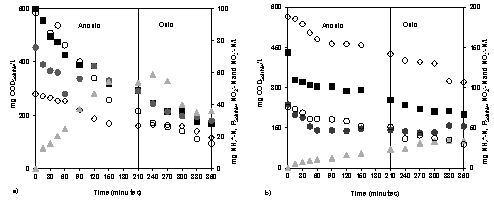 |
|
The slaughterhouse wastewater contains high amount of organic matter; therefore, a pre-treatment is necessary to hydrolyze the protein and diminish the COD concentration in order to produce wastewater of easy degradation. Sequencing batch reactor (SBR) technology has been developed to completely remove nitrogen in one single reactor combining aerobic and anoxic stages. In this work, pre-fermentation of 7 days under anaerobic conditions was carried out; achieving 78% of protein hydrolysis, 138 mg NH4+-N/L was produced and 53% of CODsoluble was diminished. Bio-degradability assays under oxic/anoxic (O/A) and anoxic/oxic (A/O) conditions using pre-fermented wastewater were performed; raw slaughterhouse wastewater was used as control assay. Low values of protein hydrolysis and removal efficiencies of COD were obtained with pre-fermented wastewater: (O/A) 44% and 46%, and (A/O) 34% and 54%, respectively; whereas with the raw wastewater the hydrolysis and COD removal efficiencies were above 60%. Higher removal efficiencies of total nitrogen were obtained with pre-fermented wastewater under O/A conditions (60%). The pre-fermentation was not able to improve the biodegradability; however, the treatment of raw wastewater under A/O conditions produced an effluent with quality to be discharged in according to Mexican Normative.
Keywords: anoxic-oxic, COD, oxic-anoxic, protein, removal, slaughterhouse.
|
|
 |

